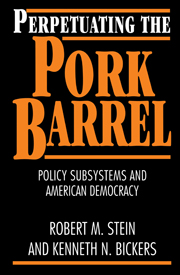Book contents
- Frontmatter
- Contents
- Tables and figures
- Acknowledgments
- PART I
- PART II
- PART III
- PART IV
- APPENDIXES
- 1 Descriptive data base of domestic assistance programs
- 2 Geographical data base of domestic assistance awards
- 3 Programs by agency and policy type
- 4 Departments and their distributive policy agencies
- 5 Federal agencies in four cabinet departments: Budgetary changes proposed by the Reagan administration for FY 1983
- 6 Financial assistance programs by public law bundle
- 7 PACs whose parent interest groups testified in hearings, grouped by public law and PAC coalition
- 8 Roll call votes in the U.S. House of Representatives on nine public laws
- 9 Probit results for House roll call votes on nine public laws
- 10 Concepts and measures
- Notes
- Bibliography
- Index
2 - Geographical data base of domestic assistance awards
Published online by Cambridge University Press: 05 June 2012
- Frontmatter
- Contents
- Tables and figures
- Acknowledgments
- PART I
- PART II
- PART III
- PART IV
- APPENDIXES
- 1 Descriptive data base of domestic assistance programs
- 2 Geographical data base of domestic assistance awards
- 3 Programs by agency and policy type
- 4 Departments and their distributive policy agencies
- 5 Federal agencies in four cabinet departments: Budgetary changes proposed by the Reagan administration for FY 1983
- 6 Financial assistance programs by public law bundle
- 7 PACs whose parent interest groups testified in hearings, grouped by public law and PAC coalition
- 8 Roll call votes in the U.S. House of Representatives on nine public laws
- 9 Probit results for House roll call votes on nine public laws
- 10 Concepts and measures
- Notes
- Bibliography
- Index
Summary
The source from which our data on the flow of federal funds to congressional districts have been constructed is the Federal Assistance Awards Data System (FAADS), which is maintained by the Bureau of the Census. As described here, we have compiled these data into a geographical data base that reports, for each domestic program and for each congressional district, the number of discrete awards, both new and ongoing, as well as the dollar value of awards. Summary tables and figures for the 1983–90 period for each congressional district are available in Bickers and Stein (1991).
FAADS is compiled by the Office of Management and Budget and maintained by the Bureau of the Census. It was established in 1981, but underwent significant evolution prior to 1983. Most important, FAADS did not identify the congressional district in which awards were made until fiscal year 1983, making it impossible to construct congressional district level figures prior to that year. From its inception, it has been available only in magnetic readable form, consisting of records that each federal agency enters by computer when the agency makes a financial assistance award to a recipient or group of recipients. In most years, the FAADS records exceed a million transactions. FAADS contains extensive information on aid awards, recipients of the aid, and the programs under which awards are made. FAADS includes most of the programs listed in the Catalog of Federal Domestic Assistance, and is keyed to the same identification codes that are used in the catalog.
- Type
- Chapter
- Information
- Perpetuating the Pork BarrelPolicy Subsystems and American Democracy, pp. 157 - 160Publisher: Cambridge University PressPrint publication year: 1995



